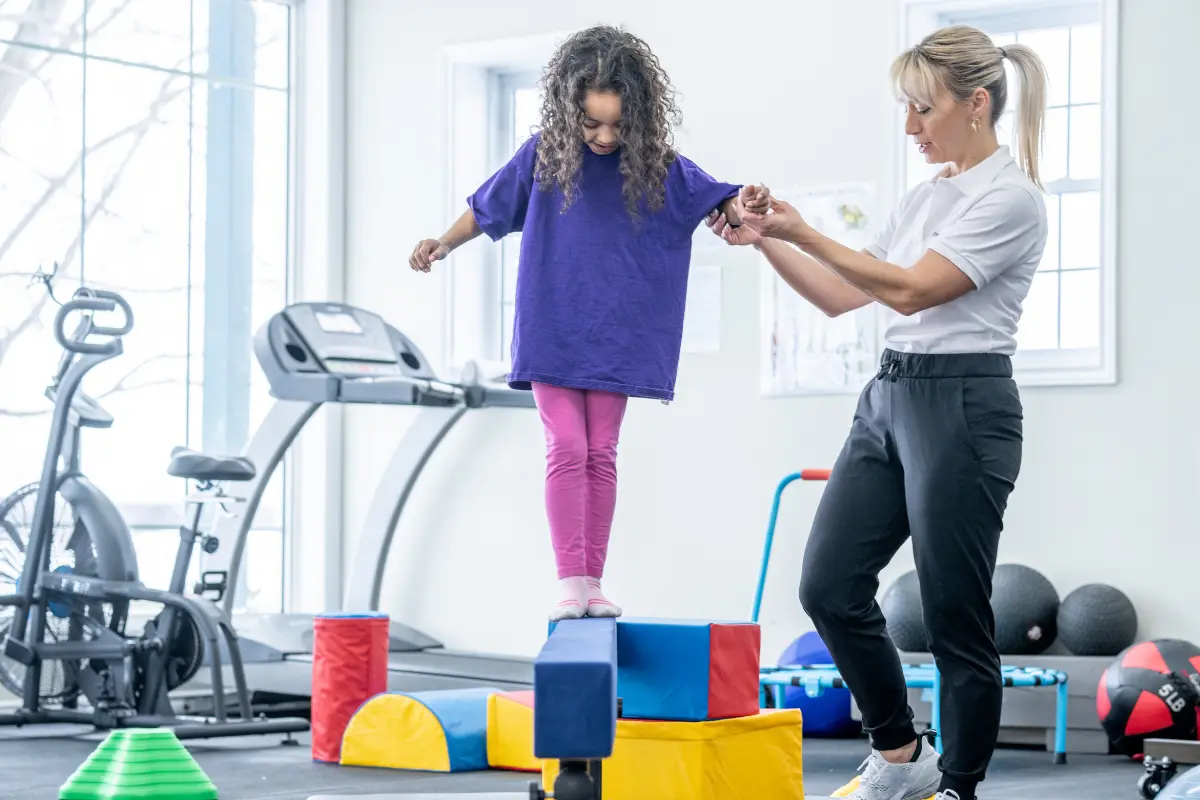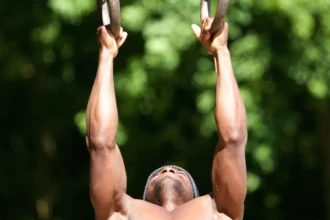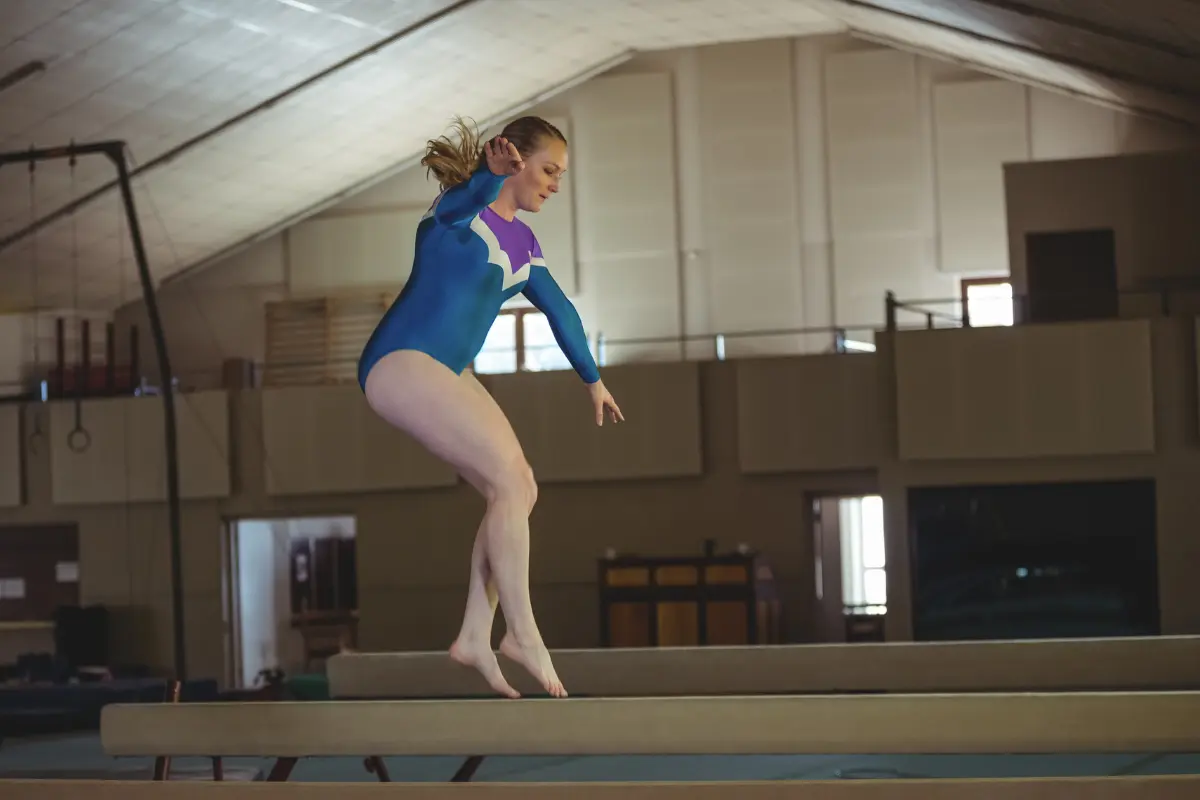Balance beam exercises are essential for building balance, coordination, and confidence in gymnastics. If you’re just starting out, it’s important to nail the basics on the beam before moving on to more advanced moves. Here are some key exercises to get you started:
1. Walking Exercises
Walking exercises on the balance beam are essential for developing balance, coordination, and body awareness. These exercises help gymnasts build the fundamental skills needed to stay stable on a narrow surface while strengthening the lower body.
1. Basic Forward Walk
The basic forward walk is the starting point for mastering balance on the beam. This exercise involves slow, controlled steps, allowing you to focus on maintaining a straight posture and stability as you move forward.
How to Perform: Begin by standing on the beam with your feet together. Extend your arms out to your sides to help with balance. Step forward with one foot, placing it flat on the beam. Then, bring the other foot forward, placing it just ahead of the first foot. Continue this process, walking across the beam one step at a time, ensuring that each foot is placed securely.
- Tip: Keep your body aligned, with your chest open and shoulders relaxed. Avoid looking down at your feet—focus on a fixed point ahead of you.
2. Toe-to-Heel Walk
The toe-to-heel walk involves stepping toe-to-heel, one foot directly in front of the other, which enhances balance and foot placement control. It’s a great way to challenge your precision and develop the strength needed to stay stable on the beam.
How to Perform: Start by standing tall on the beam with your arms extended for balance. Step forward with your toe, then bring the heel of the same foot directly in front of the other foot’s toe. Continue this pattern, moving forward one step at a time until you reach the end of the beam.
- Tip: Focus on keeping your feet in close alignment as you walk. This will help improve balance and control.
3. Heel-to-Toe Walk
The heel-to-toe walk is the reverse of the toe-to-heel walk and focuses on stepping with your heel first. This variation helps strengthen ankle control and balance by requiring more precise foot placement.
How to Perform: Stand with your arms extended for balance. Step forward with the heel of one foot, making sure it’s placed flat on the beam. Then, bring the toe of the same foot directly in front of the other foot’s heel. Continue stepping in this heel-to-toe pattern, moving forward across the beam.
Tip: Like the toe-to-heel walk, maintain precision with each step. Focus on controlling your movement and keeping your posture tall.
4. Side Walk (Side Step)
Side walking is important for improving balance and coordination in a lateral direction. It strengthens the muscles in your hips and legs while also working on balance and stability as you move sideways across the beam.
How to Perform: Stand on the beam, facing forward. Step to the side with one foot, then bring the other foot to meet it. Continue stepping sideways, one foot after the other, until you reach the end of the beam. Make sure to keep a steady rhythm as you move across.
- Tip: Keep your body tall and aligned as you side step, focusing on not leaning to one side. Extend your arms out to help with balance. Take it slow at first, as side walking requires more leg strength and stability than forward walking.
5. Backward Walk
Walking backward challenges your coordination and core strength since it’s not as intuitive as walking forward. It’s an essential skill that helps improve your overall balance and control on the beam.
How to Perform: Start by standing on the beam with your feet together. Step backward with one foot, placing the heel first on the beam. Bring the opposite foot behind you, also placing it heel-first. Continue stepping backward, one foot at a time, until you reach the end of the beam.
- Tip: Engage your core throughout the movement to keep your posture upright and maintain balance. Avoid looking down at your feet; instead, keep your head up and eyes focused straight ahead. Extend your arms for balance and take slow, controlled steps to ensure a smooth movement.
2. Basic Balancing Exercises
Balancing exercises on a beam (like a gymnastics or balance beam) take basic balance drills to the next level, adding the challenge of staying on a narrow, elevated surface. These exercises help develop core strength, body control, and precision.
1. One-Leg Balance (Passé Position)
The one-leg balance in the passé position is a great way to improve your balance and ankle control. This position is commonly used in gymnastics routines, where one leg is lifted and held while standing on the other.
How to Perform: Start by standing on the beam with your feet together and arms extended for balance. Lift one leg off the beam, bending your knee so your foot rests just below the opposite knee (this is the passé position). Hold this position for 5-10 seconds, keeping your body upright and your core engaged. Lower the lifted leg and repeat with the other leg.
- Tip: Keep your hips level and avoid leaning forward or backward. Engage your core to stay stable. If you feel unsteady, practice near a support or on a wider surface first.
2. Leg Lifts
Leg lifts are a great way to strengthen the muscles in your legs and core while improving balance and control. This exercise targets the lower body, helping to stabilize your body and prevent falls while on the beam.
How to Perform: Stand on the beam with your feet together and arms extended for balance. Slowly lift one leg straight in front of you, keeping it aligned with your body. Hold the leg up for a few seconds, then lower it. Repeat with the opposite leg. Perform 5-10 repetitions on each leg.
- Tip: Keep your body tall and avoid leaning back when lifting your leg. Engage your core to help maintain balance. As you get stronger, try holding the leg up for longer or lifting it higher.
3. Passé Hold
The passé hold is similar to the one-leg balance but focuses on holding the passé position for a longer time. This helps improve your core strength and balance.
How to Perform: Stand on the beam and lift one leg into the passé position (foot just below the opposite knee). Hold this position for 5-15 seconds, keeping your body upright and core engaged. Lower the leg and repeat with the other leg.
- Tip: Keep your posture upright and avoid tilting to one side. Engage your core and focus on a point ahead of you for stability. Start with shorter hold times and increase them as you get stronger.
3. Jumping Drills
Jumping drills on the balance beam are essential for developing explosive power, timing, and coordination. These exercises help gymnasts transition smoothly between different positions while maintaining control and stability on the beam.
1. Jump and Land
This is one of the most basic yet crucial jumping drills, helping gymnasts learn to control their body while jumping and landing on the beam. The goal is to land softly and maintain balance when returning to the beam.
How to Perform:
Stand with both feet together on the beam. Bend your knees slightly, then jump off the beam. Bring your knees up slightly to control the jump, and land softly on the beam with both feet together. Bend your knees slightly to absorb the impact.
- Tip: Focus on landing gently with both feet. Keep your core engaged to stay balanced. Start with a low beam to practice before moving to a higher one.
2. Jumping Jacks on the Beam
Jumping jacks are a great cardiovascular exercise that also works on coordination, balance, and agility. Performing them on the beam challenges the gymnast’s ability to stay balanced while performing dynamic movements with the arms and legs.
How to Perform: Stand on the beam with your feet together and arms at your sides. Jump your feet out wide while raising your arms overhead, like a normal jumping jack. Then, jump back to the starting position with your feet together and arms by your sides. Repeat for 10-15 repetitions.
- Tip: Stay light on your feet and focus on keeping your body aligned. If you feel unstable, practice on a wider surface first before moving to the beam.ms and legs. Stay light on your feet and focus on keeping your body aligned, especially during the landing.
3. Split Jumps
Split jumps are a classic gymnastics move that challenges both flexibility and coordination. Practicing split jumps on the balance beam builds leg strength and enhances your ability to maintain control while executing acrobatic movements.
How to Perform: Stand on the beam with your feet together. Push off the beam with both feet, jumping into a split position with one leg forward and the other behind you. Land softly on the beam with both feet together, bending your knees slightly to absorb the landing.
- Tip: Make sure your legs are straight during the jump, and keep your body tall. Engage your core to help with balance. Start on a wider surface before practicing on the beam.
4. Tuck Jumps
Tuck jumps are a great way to build explosive power in the legs and improve jump height. These jumps require quick coordination between the arms and legs and challenge your ability to control your movement in the air.
How to Perform: Stand on the beam with your feet together and arms at your sides. Bend your knees and jump off the beam, bringing your knees up toward your chest. Land softly on the beam, bending your knees slightly.
- Tip: Focus on getting your knees as high as possible while keeping good form. Engage your core and absorb the landing with a soft bend in your knees.
5. Jump 180-Degree Turns
This advanced jumping drill helps improve both jumping technique and rotational skills. It involves jumping and turning 180 degrees in the air, landing with control and stability. This drill is a great way to enhance your ability to execute spins and turns on the balance beam.
How to Perform: Stand on the beam with your arms out for balance. Jump off the beam, turning your body 180 degrees in the air. As you rotate, bring your arms in close to help with the turn. Land softly on the beam with both feet together.
- Tip: Jump high enough to complete the turn, and keep your body aligned. Spot your landing to make sure you land smoothly and with control.
4. Rotational Exercises
Rotational movements are not just about spinning; they require good posture, strong core muscles, and the ability to maintain balance while your body is in motion. These exercises help develop coordination, body awareness, and control during spins, turns, and other rotational movements.
1. Spotting Practice (Basic Turns)
Spotting is a technique where you keep your eyes fixed on one point while rotating, which helps you maintain balance and reduce dizziness. It’s a vital skill for all types of spins and turns.
How to Perform: Stand on the beam with your arms extended for balance. Start turning your body slowly while focusing your eyes on a fixed point ahead of you. As your body turns, quickly whip your head around to locate the same point again. Repeat this motion several times, focusing on smooth, controlled movements.
- Tip: Spotting helps reduce dizziness by allowing your body to stay aligned. Start with a simple turn and gradually increase the number of rotations as you improve your technique.
2. 180-Degree Turn (Half Turn)
The 180-degree turn (also called a half turn) is a basic rotation that teaches you how to rotate halfway around while maintaining control. This move is fundamental for building up to more advanced rotations.
How to Perform: Stand on the beam with your arms extended for balance. Bend your knees slightly and push off the beam to rotate your body 180 degrees. Use your arms and core to initiate the movement and maintain your balance during the turn. Complete the rotation and land facing the opposite direction with your feet together.
- Tip: Keep your body aligned throughout the turn. Your arms should help guide the rotation, and your core should be engaged to maintain stability. Practice turning slowly and focus on making your rotation smooth and controlled.
3. 360-Degree Turn (Full Turn)
A 360-degree turn is a complete rotation, requiring more control and fluidity. This move is essential for mastering turns and spins on the balance beam.
How to Perform: Start by standing on the beam with your arms extended for balance. Push off the beam and rotate your body 360 degrees. Engage your core and use your arms to help control the rotation. Complete the full turn and land softly with both feet together.
- Tip: Use your arms and core to control the rotation. Keep your head aligned with your body and spot a fixed point to help maintain balance. Practice slowly at first, then gradually increase the speed as you gain confidence.
4. Pirouette Turn
A pirouette is an advanced turn where you spin on one foot, requiring high levels of balance, control, and core strength. This move is great for improving rotational speed and stability.
How to Perform: Start in the passé position, with one leg bent and the foot placed near the opposite knee. Push off the beam and spin on the standing foot, rotating your body while keeping your arms close to your body to guide the spin. Complete the 360-degree turn and land softly on both feet. Practice on both legs for balance.
- Tip: Engage your core throughout the spin to keep your body tight and controlled. Spotting is key to controlling the turn and preventing dizziness. Start with a slow spin and gradually increase the speed as you get stronger.
5. Multiple Turns (Double or Triple Turns)
For more advanced gymnasts, performing double or triple turns (multiple 360-degree spins) is a challenging but important skill. These drills help you build the stamina and control needed to execute several rotations without losing balance.
How to Perform: Start by performing a 360-degree turn, then immediately continue rotating into another 360-degree turn without pausing. Focus on maintaining balance and control during each rotation. Complete two or three full turns and land softly on the beam with both feet together.
- Tip: Multiple turns require precision and endurance. Focus on smooth transitions between rotations and keep your core engaged to maintain balance throughout. Practice double turns first, then work up to triples as you gain strength and stability.
Handstands and Cartwheels
Handstands and cartwheels are important gymnastics skills that test your balance, coordination, and strength. These moves help build control and confidence, especially when performed on the balance beam.
Handstand
The handstand is when you balance on your hands with your body straight and upside down. It’s a great way to improve strength and body control.
How to Perform: Stand tall with your arms extended overhead. Take a step forward and kick one leg up into the air, followed by the other, until your body is in a straight line from your head to your toes. Hold the handstand for a few seconds, keeping your core tight. Lower one leg back to the beam, then the other, landing with control.
- Tip: If you’re new to handstands, start by practicing against a wall for support. Engage your core to keep your body aligned and avoid tipping over. Gradually practice without the wall as you get more comfortable.
Cartwheel
The cartwheel is a sideways rotation where your hands support your body as your legs split in the air. It’s great for building flexibility, strength, and balance.
How to Perform: Stand on the beam with your arms overhead. Step forward with one foot, then place your hands on the beam while rotating your legs in a split position. As your legs come down, land one foot at a time on the beam, finishing with both feet together.
- Tip: Start practicing on a flat surface or a wider beam before moving to a narrow beam. Keep your body straight and control the rotation, using your arms to guide you through the movement.
Final Words
Starting with the basics on the balance beam is key to developing the skills that will carry you through your gymnastics journey. The more you practice these foundational moves, the more confident you’ll become, setting the stage for mastering complex tricks and routines.






